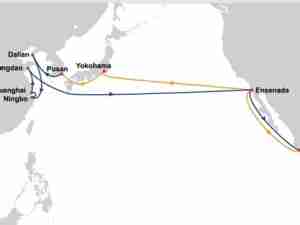Container shipping lines in the Transpacific Stabilization Agreement (TSA) are reporting full ships on their all-water East Coast services from Asia through the Panama Canal, and 90-95% vessel utilization via the US West Coast. Forward bookings received to date indicate that utilization is likely to increase in April.
With surprisingly high 13.2% cargo growth in 2005 and signals of a strengthening US economy ' low unemployment, rising wages and disposable income, interest rates at manageable levels, strong consumer confidence and retail sales ' carriers say they expect a year of strong cargo demand. And while many carriers expect to take delivery of new, larger ships for their Pacific services, port and inland transportation constraints will limit effective vessel capacity to within about 3 percentage points of demand.
'We simply don't see a downside at this point,' said TSA Executive Director Albert A. Pierce. 'Carriers are looking at their forward bookings, they're reporting cargo being bumped to later sailings at Asian ports ' not exactly a market that indicates dramatic excess capacity and falling freight rates."
Pierce acknowledged that Asia-US demand growth is likely to slow somewhat during 2006-07, as China steers investment toward public infrastructure spending and meeting domestic demand, and as rising interest rates and cooling home prices dampen consumer purchasing power. But he said carriers anticipate a gradual slowing of cargo growth, not a steep dropoff.
Several factors, meanwhile, are expected to reduce effective ship capacity growth in the next two years: the inability of most US ports to receive 8,000+ teu ships fully loaded; long lead times in developing and expanding harbor terminals; 'cascading' of smaller vessels out of the Pacific as they are replaced; capacity limitations through the Panama Canal; rail equipment shortages and system capacity constraints; and driver shortages in the trucking sector. 'Solutions to the big-ticket infrastructure problems are still at least two years off, and the current network is badly strained,' Pierce explained. 'the result is that a 14-15% increase in ship capacity is effectively an 11-12% increase.'
TSA dismissed recent analyst forecasts of overcapacity and downward pressure on rates in 2006-07. These forecasts tend to be overly reliant on modeling and computer formulas, and use rated vessel capacity data from shipyard sources, not effective capacity after factoring in operating constraints. If anything, Pierce said, rising inland rail, trucking, Panama Canal, equipment repositioning and maintenance, information system, environmental and other costs will be pushing rates upward in the coming year. A TSA cost analysis completed in November 2005 estimates increases in transpacific carrier costs of at least $150 per 40-foot container (FEU) to the West Coast, $350 per FEU for minilandbridge and inland intermodal moves, and $400 per FEU for all-water shipments to the East Coast.
'Very few service contracts for the coming year have been signed to date so it's a little early for predictions,' Pierce said, 'but TSA lines are proceeding with bids and discussions from the assumption of a robust market, high utilization year-round, a strong peak season and intense cost pressures on premium-service carriers.'
TSA is a voluntary discussion and research forum of 11 major container shipping lines serving the trade from Asia to ports and inland points in the U.S. More information on TSA can be found at www.tsacarriers.org. TSA members include:
American President Lines, Ltd.
Kawasaki Kisen Kaisha, Ltd. (K Line)
COSCO Container Lines, Ltd.
Mitsui O.S.K. Lines, Ltd.
Evergreen Marine Corp. (Taiwan), Ltd.
Nippon Yusen Kaisha (N.Y.K. Line)
Hanjin Shipping Co., Ltd.
Orient Overseas Conta





